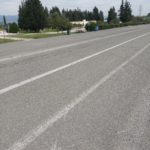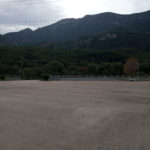Welcome to our in-depth exploration of the Battle of Thermopylae, one of history’s most intriguing conflicts. This historic battle, which took place in 480 BC between Greek city-states and the Persian Empire, holds a wealth of fascinating details that continue to captivate scholars and history enthusiasts alike. From ancient strategies employed by the Greeks to its profound historical impact, the Battle of Thermopylae remains an enduring topic of interest.
Key Takeaways:
- The Battle of Thermopylae symbolizes courage, sacrifice, and the fight for freedom against tyranny.
- Ancient strategies used by the Greeks, such as the tight phalanx formation and the utilization of the narrow pass at Thermopylae, showcased tactical innovation.
- While the Greeks ultimately lost the battle, their heroic resistance inflicted significant casualties on the Persian forces.
- The Battle of Thermopylae had a lasting impact on Greek culture, inspiring retellings in literature, art, and film.
- It demonstrated the importance of strategy, terrain, and discipline in warfare, influencing the tactics of future military campaigns.
The Legacy of Sparta: The Battle of Thermopylae
The Battle of Thermopylae holds a significant place in history, and its legacy is often associated with the renowned city-state of Sparta. The battle showcased the unmatched bravery and exceptional skills of the Spartan warriors, solidifying their reputation as formidable fighters in ancient Greece.
The Spartans’ heroic last stand at Thermopylae has become legendary, and their unwavering determination in the face of overwhelming odds has been immortalized in songs and monuments. This battle has played a crucial role in shaping the legacy of Sparta as a symbol of courage, sacrifice, and unwavering loyalty to one’s homeland.
The incredible display of Spartan valor at Thermopylae has left an indelible mark on history, cementing their status as the epitome of warrior culture. Their unwavering commitment to defending their land against the Persian Empire has inspired countless generations, making the Battle of Thermopylae an enduring symbol of heroism and the fight for freedom.
“The Spartans’ heroism at Thermopylae will forever echo through the annals of history, reminding us of the extraordinary feats that can be accomplished when brave hearts unite in the face of adversity.”
Misconceptions and Misrepresentations of Thermopylae
Throughout history, the Battle of Thermopylae has been surrounded by various misconceptions and misrepresentations. One of the most common misconceptions is the belief that there were exactly 300 Spartans at the battle. In reality, there were 301 Spartans, including King Leonidas. This small detail often gets overlooked, but it is important to accurately understand the historical events.
Another commonly misrepresented aspect of the battle is the famous one-liners attributed to the Spartans. Quotes like “Come and get them” and “Tonight we dine in hell” have become iconic, but they are likely later inventions and not historically accurate. It is essential to separate myth from reality when studying historical events like Thermopylae.
“Come and get them” and “Tonight we dine in hell” – iconic quotes attributed to the Spartans.
By addressing these misconceptions and misrepresentations, we can gain a clearer understanding of the Battle of Thermopylae and its historical significance. It is important to rely on accurate information and historical records to truly appreciate the bravery and sacrifice demonstrated by the Spartans and the other Greek city-states who fought against the Persian Empire.
| Misconceptions | Correction |
|---|---|
| 300 Spartans | 301 Spartans, including King Leonidas |
| Attributed quotes | Likely later inventions, not historically accurate |
The Battle of Thermopylae in Modern Politics
Throughout history, the Battle of Thermopylae has garnered attention and has been used as a symbol in modern politics. This ancient battle, which took place in 480 BC between the Greek city-states and the Persian Empire, has been manipulated and misused by certain political groups to further their agendas.
One notable example is the UK Conservative Party’s European Research Group, often referred to as “The Spartans.” They have adopted the Spartan image associated with Thermopylae to portray themselves as warriors defending British interests against the European Union. This political reference reflects the misappropriation of historical events for contemporary political purposes.
“The Spartans” reference by the UK Conservative Party illustrates how the Battle of Thermopylae has been distorted in modern politics, where historical symbols are exploited to validate specific ideologies or agendas. It is crucial to separate the historical significance of Thermopylae from its contemporary misrepresentation.”
Another instance of the Battle of Thermopylae being misused is by the Greek neo-Nazi party Golden Dawn. They have held rallies at the modern-day site of Thermopylae, attempting to associate themselves with the heroic Spartans and promote their extremist ideology. This manipulation of history not only distorts the true meaning of the battle but also undermines the historical sacrifices made by the Greek city-states.
Table: Modern Political Misuse of the Battle of Thermopylae
| Political Group | Actions |
|---|---|
| UK Conservative Party’s European Research Group | Referring to themselves as “The Spartans” to champion British interests against the European Union. |
| Greek neo-Nazi party Golden Dawn | Organizing rallies at the modern-day site of Thermopylae, exploiting the battle for their extremist ideology. |
In conclusion, the Battle of Thermopylae has been used and misused in modern politics, with certain political groups appropriating its historical significance to legitimize their ideologies. It is crucial to understand the true historical context and separate it from the contemporary distortions. By recognizing and challenging these misrepresentations, we can ensure a more accurate understanding of history and avoid the manipulation of historical events for political gain.
The Influence of “300” on the Battle of Thermopylae
The film “300,” directed by Zac Snyder and released in 2007, has had a significant impact on the popular image of the Battle of Thermopylae. The movie portrays the Spartans as heroic warriors, clad in leather speedos and red cloaks. The film’s depiction has influenced the way the Battle of Thermopylae is visually interpreted and has become a defining representation of the Spartans in popular culture.
The film’s stylized visuals, intense action sequences, and memorable quotes, such as “This is Sparta!” have permeated mainstream consciousness, cementing the image of the 300 Spartans as relentless fighters against overwhelming odds. The film’s success sparked a renewed interest in the Battle of Thermopylae, prompting many to delve into the historical accounts and seek a deeper understanding of the event.
“300” transformed a historical battle into a cinematic spectacle, capturing the imaginations of audiences worldwide. While the movie takes creative liberties with the historical accuracy of certain aspects, it undeniably reinvigorated interest in the Battle of Thermopylae and brought the story to a broader audience.”
The Film’s Influence on Pop Culture
The impact of “300” extends beyond its portrayal of the Battle of Thermopylae. The film’s stylized visuals, iconic characters, and quotable lines have seeped into various forms of media, including video games, television shows, and graphic novels. The image of the 300 Spartans standing in formation, shields locked, has become a universal symbol of courage and resilience.
Furthermore, the success of “300” has led to a wave of historical epics and action films inspired by its formula. The film’s distinctive visual style, slow-motion fight scenes, and larger-than-life heroes have become hallmarks of the genre, influencing subsequent projects and solidifying its place in cinematic history.
| Impact of “300” on the Battle of Thermopylae | Impact on Pop Culture |
|---|---|
| Increased interest in the Battle of Thermopylae | Inspired numerous video games, TV shows, and graphic novels |
| Shaped the visual interpretation of the Battle | Popularized stylized visuals and slow-motion fight scenes |
| Presented the 300 Spartans as iconic heroes | Influenced subsequent historical epics and action films |
In conclusion, “300” has undoubtedly left a lasting impact on both the Battle of Thermopylae and popular culture. The film’s portrayal of the Spartans has become synonymous with heroism and bravery, while its visual style and memorable quotes have permeated various forms of media. Although “300” takes creative liberties with historical accuracy, it continues to captivate audiences and spark interest in one of history’s most iconic battles.
The Battle of Thermopylae in Historical Context
The Battle of Thermopylae took place within the larger context of the conflict between the Persian Empire and the Greek city-states. Led by King Xerxes, the Persian Empire sought to expand its influence and control over Greece, while the Greek city-states formed the Hellenic League to resist the invasion. Thermopylae, with its narrow pass, became a crucial defensive line in this ongoing struggle.
The battle played a significant role in shaping the outcome of the overall war. The Greeks, led by King Leonidas, utilized the terrain and their strategic positioning to their advantage. They formed a tight phalanx formation, a shield wall of soldiers standing shoulder to shoulder, which was highly effective against the Persian attacks. The Persians, on the other hand, sought to overwhelm the Greeks with their vast numbers and tried to outflank them through the Anopaia path.
This clash of tactics and strategies demonstrated the importance of strategy, terrain, and discipline in determining the outcome of conflicts. While the Greeks ultimately lost the Battle of Thermopylae, their heroic resistance inflicted significant casualties on the Persian forces. The battle bought valuable time for the Greek city-states to regroup and prepare for future battles, ultimately leading to their victory in the Persian Wars.
| Key Players | King Xerxes | King Leonidas |
|---|---|---|
| Leadership | Commander of the Persian Empire | Leader of the Greek city-states |
| Goals | Expand Persian influence and control over Greece | Resist the Persian invasion and maintain Greek independence |
| Strategies | Overwhelm the Greeks with vast numbers | Utilize the narrow pass and employ a tight phalanx formation |
| Outcome | Victorious, but with significant casualties | Defeated, but bought time for the Greek city-states to regroup |
The Battle of Thermopylae, therefore, was not just a single isolated event but a crucial part of a larger historical conflict. It exemplifies the struggle between the Persian Empire and the Greek city-states and highlights the significance of strategy, terrain, and unity in determining the course of history. The battle’s historical context is essential in understanding its lasting impact on Greek culture, warfare, and the human spirit.
The Tactics and Strategies of the Battle of Thermopylae
The Battle of Thermopylae was a showcase of tactical innovation and strategic prowess by both the Greek and Persian forces. Led by King Leonidas, the Greeks utilized the topography of the narrow pass at Thermopylae to their advantage. They formed a tight phalanx formation, a dense infantry formation with overlapping shields and long spears, to withstand the Persian attacks. This formation allowed them to effectively repel wave after wave of enemy forces, inflicting heavy casualties and prolonging their defense.
On the other side, the Persians, under the command of King Xerxes, employed their numerical superiority as their main advantage. They attempted to outflank the Greeks through the treacherous Anopaia path, aiming to attack them from the rear. This bold maneuver demonstrated the Persian’s willingness to adapt their strategy in response to the Greek defensive tactics.
“The Greeks fought like lions, holding their ground against the overwhelming Persian forces. Their phalanx formation was a testament to their discipline and unity.” – Ancient Greek historian, Herodotus
Despite their ultimate defeat, the Battle of Thermopylae highlighted the importance of terrain and strategy in determining the outcome of conflicts. It showcased that a smaller, well-prepared force could significantly delay and inflict heavy losses upon a larger adversary. The battle’s tactics and strategies continue to be studied and analyzed by military strategists throughout history, serving as valuable lessons in warfare.
| Tactics | Benefits | Drawbacks |
|---|---|---|
| Phalanx Formation | – Provided a solid defensive barrier – Allowed for coordinated pushing and spearing |
– Vulnerable to flanking maneuvers – Limited mobility |
| Narrow Pass Defense | – Limited the Persian numbers and hindered their ability to effectively engage – Made it difficult for the Persians to unleash their full force |
– Restricted the Greeks’ mobility and room for maneuvering – Increased their vulnerability to being surrounded |
| Persian Outflanking Attempt | – Demonstrated adaptability and willingness to change strategy – Created a sense of uncertainty among the Greeks |
– Required navigating treacherous terrain – Risked exposing the Persian rear to potential counterattacks |
The Outcome and Significance of the Battle of Thermopylae
The Battle of Thermopylae, while ultimately resulting in Greek defeat, holds immense historical significance and continues to inspire generations with its tale of heroism and sacrifice. Despite the overwhelming numerical advantage of the Persian forces, the Greeks, led by King Leonidas and his 300 Spartans, fought valiantly, inflicting heavy casualties upon the enemy. This display of courage and resistance bought crucial time for the Greek city-states to regroup and forge ahead towards victory in the Persian Wars.
Although the battle’s outcome was not in favor of the Greeks, their unwavering determination and selfless defense of their homeland left an indelible mark on history. The Battle of Thermopylae has come to symbolize the relentless fight against tyranny and oppression. It serves as a reminder that even in the face of seemingly insurmountable odds, the human spirit can endure and triumph.
“The Battle of Thermopylae is not just a historical event; it represents the triumph of the human spirit in the face of adversity.” – Anonymous
Beyond its immediate impact, the Battle of Thermopylae significantly shaped the course of the Persian Wars and the subsequent development of Greek culture and civilization. The Greek victory in the Persian Wars marked a turning point in history, preserving the ideals of democracy and laying the foundation for the flourishing of arts, sciences, and philosophy during the Golden Age of Athens.
| Outcome | Significance |
|---|---|
| The Greeks were defeated, but their heroic resistance inflicted significant casualties on the Persian army. | The battle rallied the Greek city-states, leading to their eventual victory in the Persian Wars and the preservation of their way of life. |
| The battle bought time for the Greeks to regroup and prepare for future battles. | The Greek victory in the Persian Wars ensured the survival of democracy and laid the groundwork for the cultural and intellectual flourishing of the Golden Age of Athens. |
| Despite the defeat, the Battle of Thermopylae became an enduring symbol of heroism and sacrifice. | The battle’s legacy continues to inspire individuals and nations, serving as a testament to the power of unity, bravery, and the fight for freedom. |
The Battle of Thermopylae’s Lasting Impact
The Battle of Thermopylae holds a lasting impact on Greek culture that resonates to this day. It stands as a symbol of courage, sacrifice, and the indomitable human spirit in the face of overwhelming adversity. The battle’s legacy has inspired numerous retellings in literature, art, and film, capturing the imagination of people worldwide.
The Battle of Thermopylae’s influence extends beyond artistic interpretations. It has become a touchstone for individuals facing their own struggles against oppression. The heroic resistance of the Greek city-states exemplifies the unwavering determination to fight for freedom, and this message continues to inspire individuals and communities in their own quests for justice.
“The Battle of Thermopylae is a shining example of the strength that can be found in unity, sacrifice, and bravery.”
Furthermore, the battle’s impact reaches into the realms of warfare and military strategy. The Greeks’ use of the phalanx formation and their ability to leverage the narrow pass of Thermopylae showcased the importance of strategy, discipline, and terrain in determining the outcome of conflicts. Military strategists throughout history have studied the Battle of Thermopylae for its tactical innovations and lessons in warfare.
The Battle of Thermopylae’s Lasting Impact in Greek Culture
The Battle of Thermopylae has left an indelible mark on Greek culture. It serves as a reminder of the timeless values of courage, sacrifice, and the relentless pursuit of freedom. The battle’s enduring legacy continues to inspire and uplift individuals, resonating with the human spirit’s innate desire to overcome challenges and triumph over adversity.
| Impact | Explanation |
|---|---|
| Artistic Interpretations | The battle has been immortalized through literature, art, and film. Its portrayal in popular culture has contributed to the enduring image of the brave Spartans. |
| Inspiration | The battle serves as a source of inspiration for individuals facing their own struggles, providing a beacon of hope and a reminder of the strength found in unity and determination. |
| Warfare and Strategy | The tactics and strategies employed in the Battle of Thermopylae continue to be studied by military strategists, offering valuable insights into the importance of strategy and terrain in warfare. |
The Battle of Thermopylae in Warfare
The Battle of Thermopylae highlighted the importance of strategy, terrain, and discipline in warfare. The Greeks’ use of the phalanx formation, along with their ability to maximize the advantages of the narrow pass at Thermopylae, demonstrated that smaller, well-disciplined forces could stand against numerically superior armies. This tactical innovation allowed the Greeks to hold off the Persian forces for several days, inflicting significant casualties and buying time for their allies to regroup.
The phalanx formation, characterized by tightly packed ranks of hoplite soldiers carrying spears and shields, created a formidable defensive barrier. The overlapping shields provided excellent protection and allowed the soldiers to advance together as a cohesive unit. The disciplined nature of the phalanx meant that each soldier had a specific role and position, ensuring the formation maintained its integrity even under intense pressure.
“In battle, the phalanx was a formidable force,” said General Strategos, a military historian. “It allowed the Greeks to use their limited numbers to great effect, holding back the Persian forces despite being outnumbered. The Battle of Thermopylae emphasized the importance of discipline, unit cohesion, and exploiting the terrain to gain an advantage in warfare.”
Furthermore, the narrow pass at Thermopylae played a crucial role in the Greek defense. The geography restricted the Persian army’s ability to fully utilize its numerical advantage, as only a limited number of soldiers could engage the Greeks at any given time. This allowed the Greeks to exploit the confined space and effectively fend off the Persian attacks.
| Greek Phalanx | Persian Army | |
|---|---|---|
| Tactics | Phalanx formation, tightly packed ranks, overlapping shields | Coordinated attacks, use of archers and cavalry |
| Strengths | Discipline, unity, terrain advantage | Numerical superiority, archers, cavalry |
| Weaknesses | Reliance on tight formation, vulnerability to flanking | Difficulty coordinating attacks, limited effectiveness in narrow pass |
| Outcome | Limited Greek casualties, inflicted significant losses on the Persians | Heavy Persian casualties, inability to break through Greek defense |
Conclusion
The Battle of Thermopylae stands as an enduring symbol of heroism, sacrifice, and the fight for freedom against tyranny. While the Greeks may have ultimately lost the battle, their courageous resistance inflicted significant casualties on the Persian forces. This heroic stand bought valuable time for the Greek city-states to regroup and prepare for future battles, ultimately leading to their victory in the Persian Wars.
Throughout history, the Battle of Thermopylae has left an indelible mark on Greek culture, warfare, and the human spirit. It has inspired countless retellings in literature, art, and film, becoming a defining representation of courage and unity in the face of overwhelming adversity. The battle’s legacy continues to resonate with people facing their own struggles against oppression.
Furthermore, the Battle of Thermopylae has had a lasting impact on military strategy. The tactical innovations showcased by the Greeks, particularly their use of the phalanx formation and their ability to exploit the advantages of the narrow pass, have been studied and analyzed by military strategists throughout the ages. The battle has taught valuable lessons about the importance of strategy, terrain, and discipline in warfare.
In conclusion, the Battle of Thermopylae holds a place of prominence in history due to its historical significance and its enduring impact on Greek culture and warfare. It serves as a powerful reminder of the strength of unity, sacrifice, and bravery in the face of adversity. The battle’s legacy will continue to inspire future generations and remind us of the indomitable human spirit.
FAQ
What is the Battle of Thermopylae?
The Battle of Thermopylae is a historic battle that took place in 480 BC between Greek city-states and the Persian Empire.
What is the significance of the Battle of Thermopylae?
The battle is known for its incredible courage, tactical innovation, and leadership demonstrated by the Greeks. It has a lasting impact and is often studied for its ancient strategies and historical impact.
How does the Battle of Thermopylae relate to Sparta?
The battle is often associated with Sparta and plays a significant role in the legacy of the ancient city-state. It showcased the bravery and skill of the Spartans, solidifying the idea that they were warriors without peers in ancient Greece.
What are some misconceptions about the Battle of Thermopylae?
One common misconception is that there were exactly 300 Spartans at the battle. In reality, there were 301 Spartans, including King Leonidas. Additionally, the famous one-liners attributed to the Spartans, such as “Come and get them” and “Tonight we dine in hell,” are likely later inventions and not historically accurate.
How is the Battle of Thermopylae used in modern politics?
The battle is sometimes misused in modern politics as a symbol for East vs. West conflicts. Certain political groups have appropriated the Spartan image associated with Thermopylae to legitimize their ideologies.
How has the film “300” influenced the popular image of the Battle of Thermopylae?
The film “300” has had a significant impact on the popular image of the battle. Its portrayal of the Spartans as heroic warriors has influenced the way the Battle of Thermopylae is visually interpreted and has become a defining representation of the Spartans in popular culture.
What is the historical context of the Battle of Thermopylae?
The battle took place within the context of the larger conflict between the Persian Empire and the Greek city-states. The Persians, led by King Xerxes, sought to expand their influence and control over Greece, while the Greek city-states formed the Hellenic League to resist the Persian invasion.
What tactics were used in the Battle of Thermopylae?
The Greeks, led by King Leonidas, utilized the narrow pass of Thermopylae to their advantage, employing a tight phalanx formation to repel the Persian attacks. The Persians, on the other hand, used their vast numbers and attempted to outflank the Greeks through the Anopaia path.
What was the outcome and significance of the Battle of Thermopylae?
While the Greeks ultimately lost the battle, their heroic resistance inflicted significant casualties on the Persian forces. The battle bought time for the Greek city-states to regroup and prepare for future battles, ultimately leading to their victory in the Persian Wars.
What is the lasting impact of the Battle of Thermopylae?
The battle has had a lasting impact on Greek culture and warfare. It symbolizes courage, sacrifice, and the indomitable human spirit in the face of overwhelming adversity. The battle’s legacy has inspired retellings in literature, art, and film, and it continues to resonate with people facing their own struggles against oppression.
How has the Battle of Thermopylae influenced warfare?
The battle highlighted the importance of strategy, terrain, and discipline in warfare. The Greeks’ use of the phalanx formation and their ability to maximize the advantages of the narrow pass at Thermopylae demonstrated that smaller, well-disciplined forces could stand against numerically superior armies.
Source Links
- https://www.historyhit.com/why-does-the-battle-of-thermopylae-matter-2500-years-on/
- https://www.thecollector.com/300-spartans-battle-thermopylae-story/
- https://englishpluspodcast.com/the-battle-of-thermopylae-a-detailed-analysis-of-the-iconic-struggle/
Author Profile
-
Welcome to e-thermopyles.gr, your gateway to the fascinating world of Thermopylae and the legendary Spartans. My name is George Margaritis, and I’m the proud owner and writer behind this website.
A Passion for History and the Spartan Legacy
I consider myself fortunate to call the historic site of Thermopylae my home. From a young age, I was captivated by history, and in particular, the incredible tale of the Battle of Leonidas in Thermopylae. The valiant stand of King Leonidas and his 300 Spartans against overwhelming odds has left an indelible mark on the annals of history.
As I delved deeper into this captivating story, my fascination only grew. The bravery, strategy, and sacrifice of those Spartan warriors resonated with me, and I wanted to share this rich history with the world. That’s why I created e-thermopyles.gr, a platform dedicated to exploring and uncovering the depths of knowledge surrounding Thermopylae and the Spartans.
Latest entries
 HistoryOctober 31, 2023Exploring Why is the Battle of Thermopylae Interesting
HistoryOctober 31, 2023Exploring Why is the Battle of Thermopylae Interesting GuidesOctober 31, 2023Your Guide to the Athens to Thermopylae Train Journey
GuidesOctober 31, 2023Your Guide to the Athens to Thermopylae Train Journey GuidesOctober 31, 2023Uncover the Mystery: Where is Thermopylae Today?
GuidesOctober 31, 2023Uncover the Mystery: Where is Thermopylae Today? GuidesOctober 31, 2023Uncover History by Visiting Thermopylae – A Travel Guide
GuidesOctober 31, 2023Uncover History by Visiting Thermopylae – A Travel Guide






